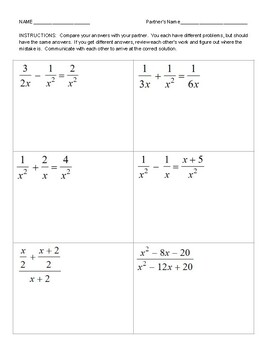Algebra 2 Rational Expressions Culturally Responsive Review Activity
Mr Buck
20 Followers
Grade Levels
9th - 12th, Higher Education, Adult Education, Homeschool
Subjects
Resource Type
Standards
CCSSHSA-CED.A.1
CCSSHSA-REI.A.2
CCSSCCRA.SL.1
CCSSMP6
Formats Included
- PDF
Pages
2 pages
Mr Buck
20 Followers
Description
Review solving rational expressions with this twinning activity. Students are partnered up in pairs and each receive a set of 6 problems. Though the problems are different, each partner should get the same answer.
The rules are as follows:
- Partners may not move on to the next problem without having both agreed on the answer.
- If a partner finishes a problem before the other, they must watch their partner's work and check it for errors as they work.
- If partners disagree on an answer, they must explain their process to each other and revise their work or each others until they agree.
- The teacher will give no answers.
- It's not a race and partners should finish together.
This review activity is for early in simplifying rational equations and is good for substitute days as it's self-managed for the most part.
Total Pages
2 pages
Answer Key
N/A
Teaching Duration
45 minutes
Report this resource to TPT
Reported resources will be reviewed by our team. Report this resource to let us know if this resource violates TPT’s content guidelines.
Standards
to see state-specific standards (only available in the US).
CCSSHSA-CED.A.1
Create equations and inequalities in one variable and use them to solve problems.
CCSSHSA-REI.A.2
Solve simple rational and radical equations in one variable, and give examples showing how extraneous solutions may arise.
CCSSCCRA.SL.1
Prepare for and participate effectively in a range of conversations and collaborations with diverse partners, building on others’ ideas and expressing their own clearly and persuasively.
CCSSMP6
Attend to precision. Mathematically proficient students try to communicate precisely to others. They try to use clear definitions in discussion with others and in their own reasoning. They state the meaning of the symbols they choose, including using the equal sign consistently and appropriately. They are careful about specifying units of measure, and labeling axes to clarify the correspondence with quantities in a problem. They calculate accurately and efficiently, express numerical answers with a degree of precision appropriate for the problem context. In the elementary grades, students give carefully formulated explanations to each other. By the time they reach high school they have learned to examine claims and make explicit use of definitions.



